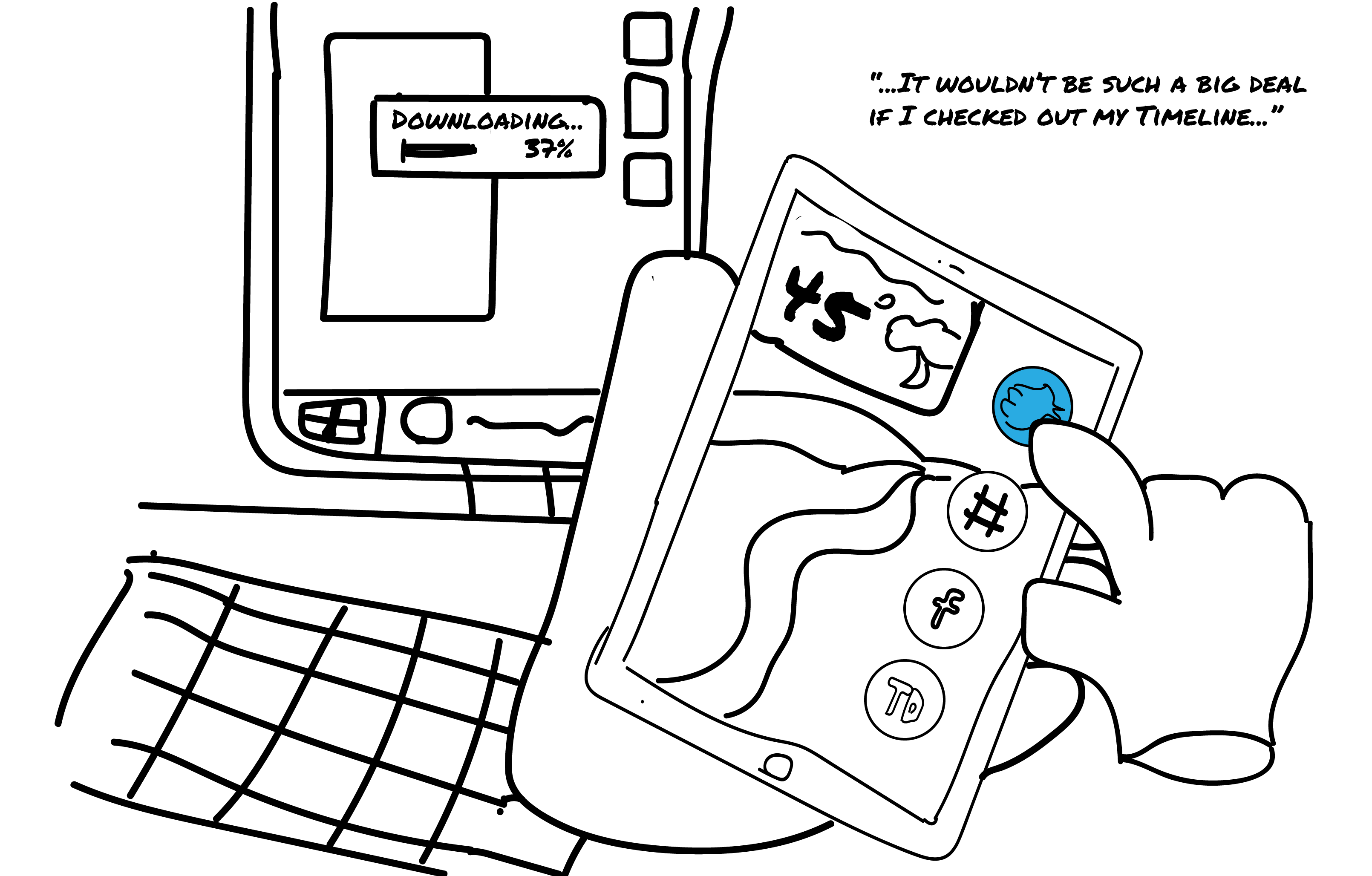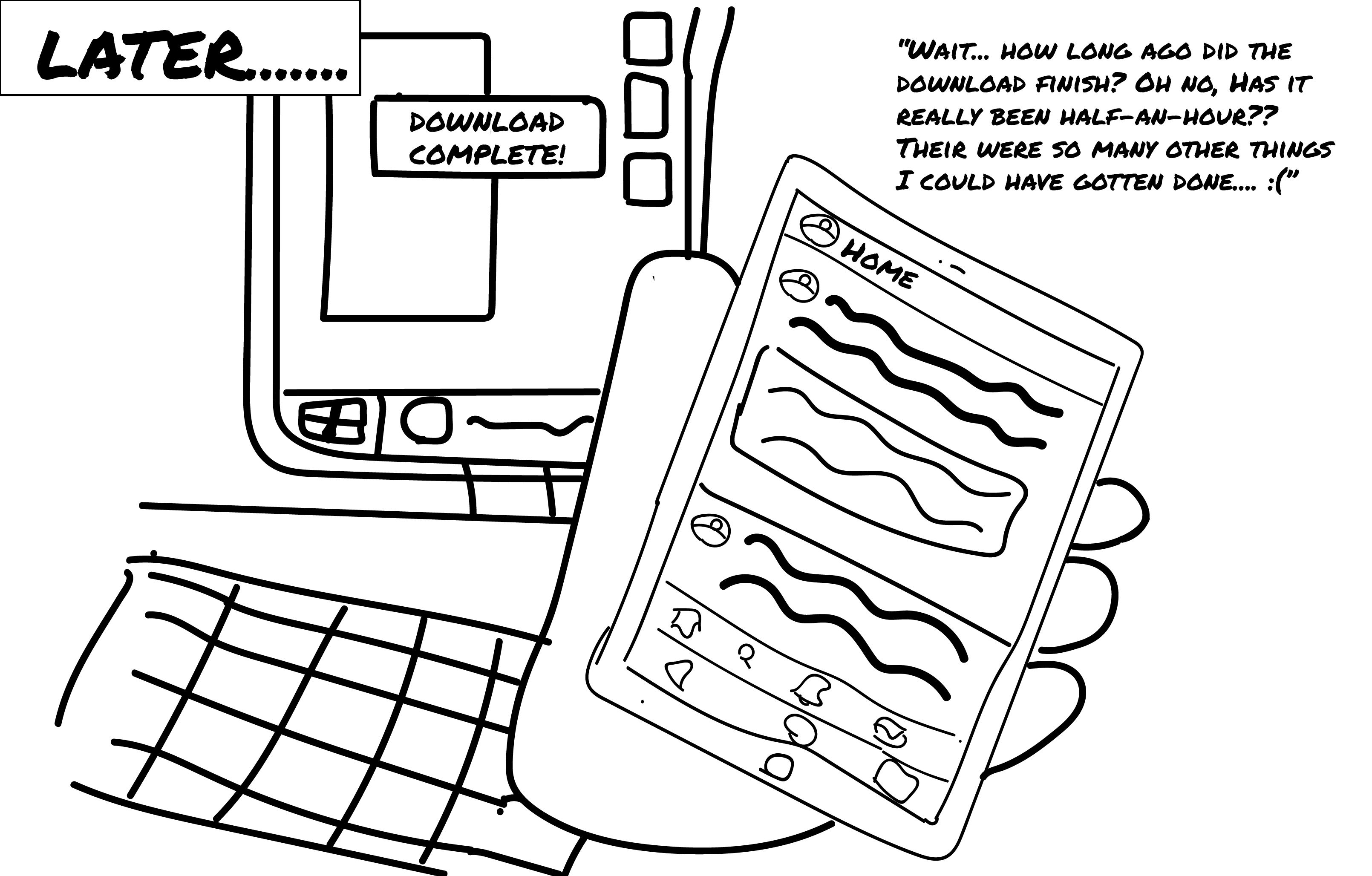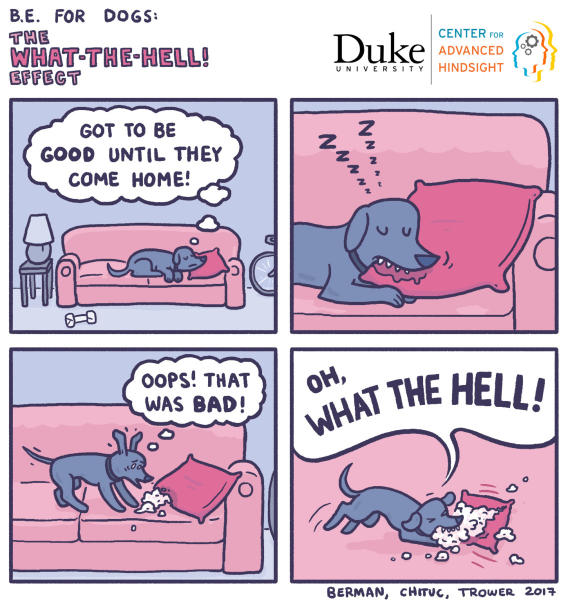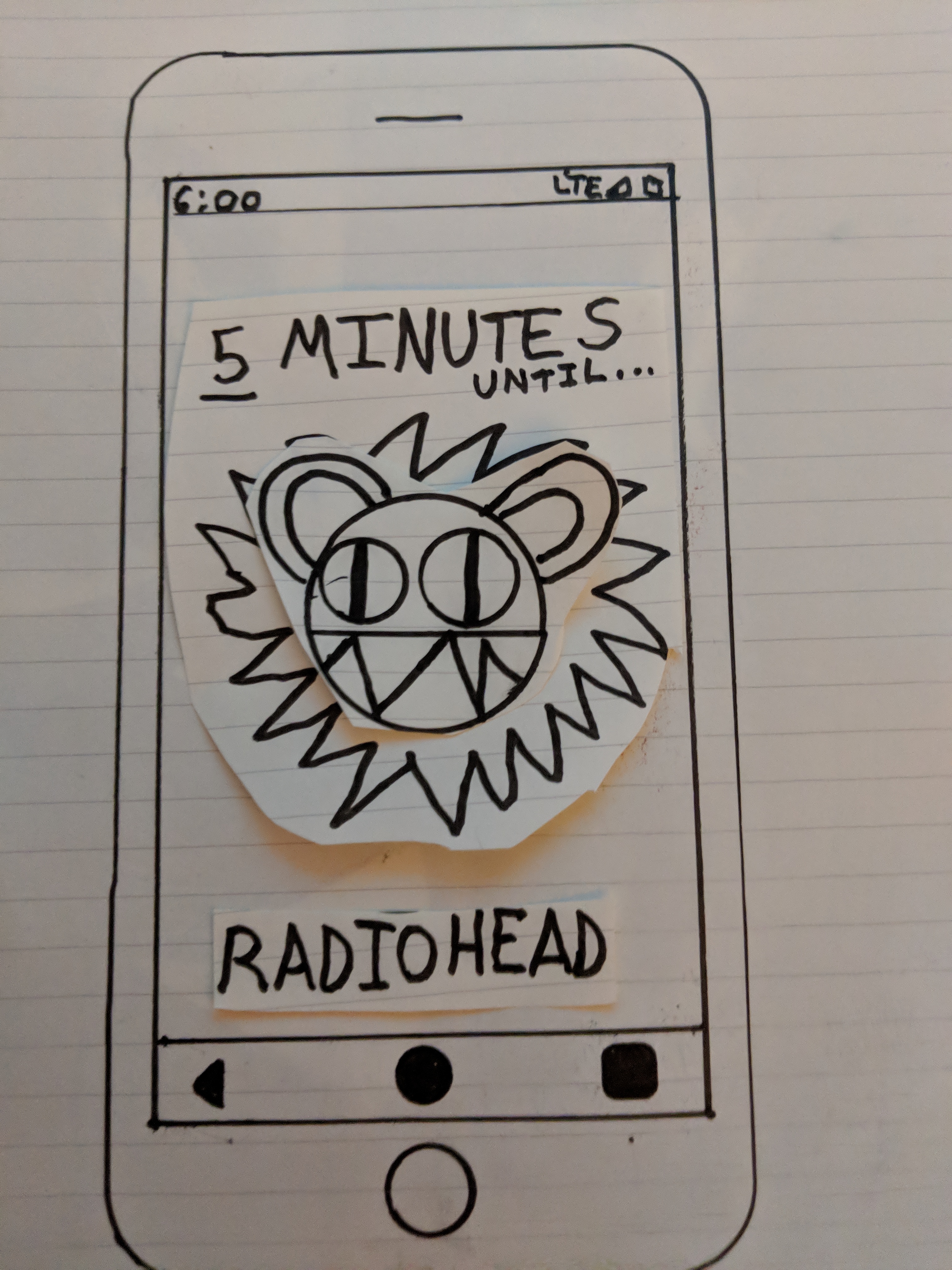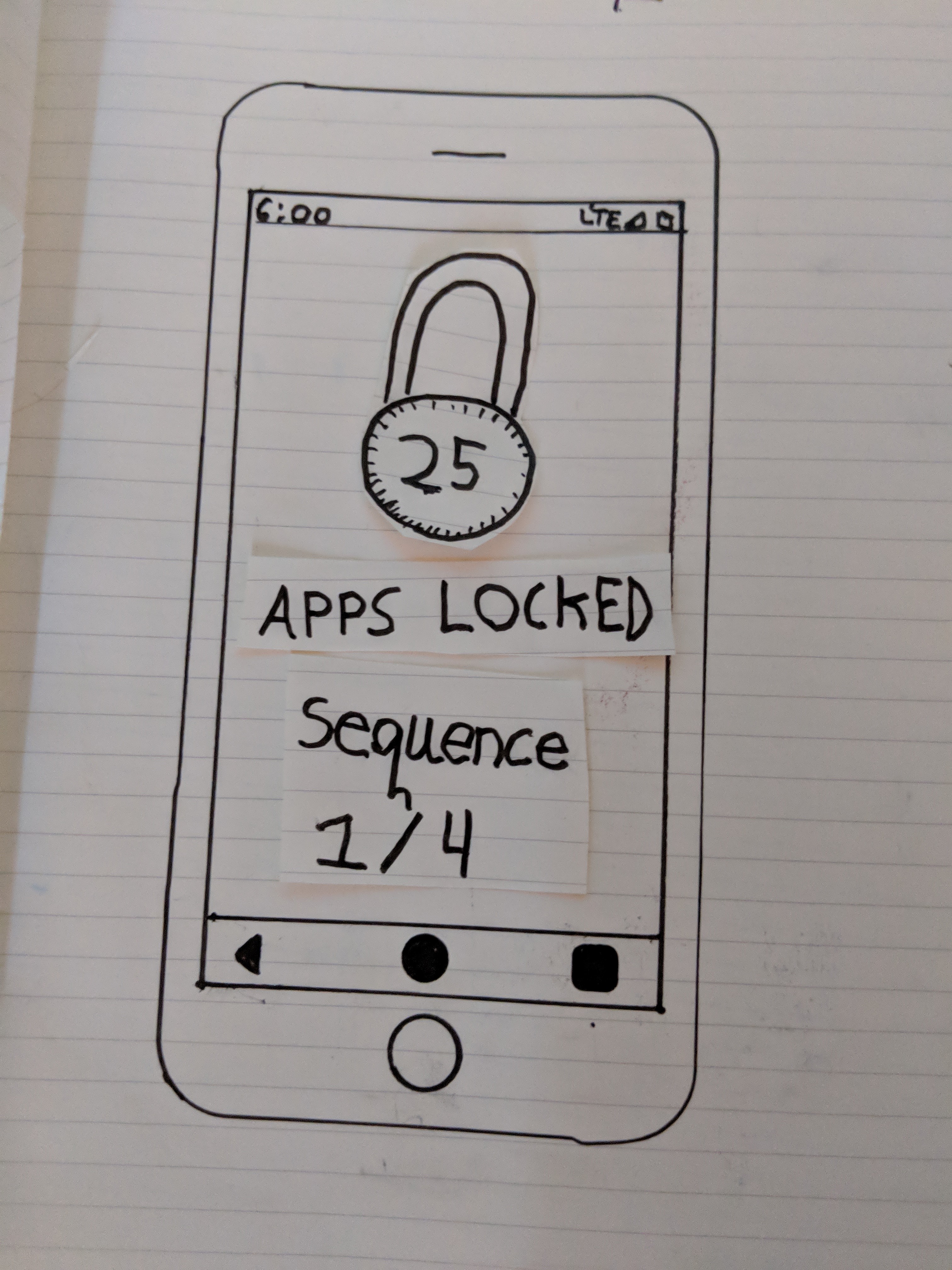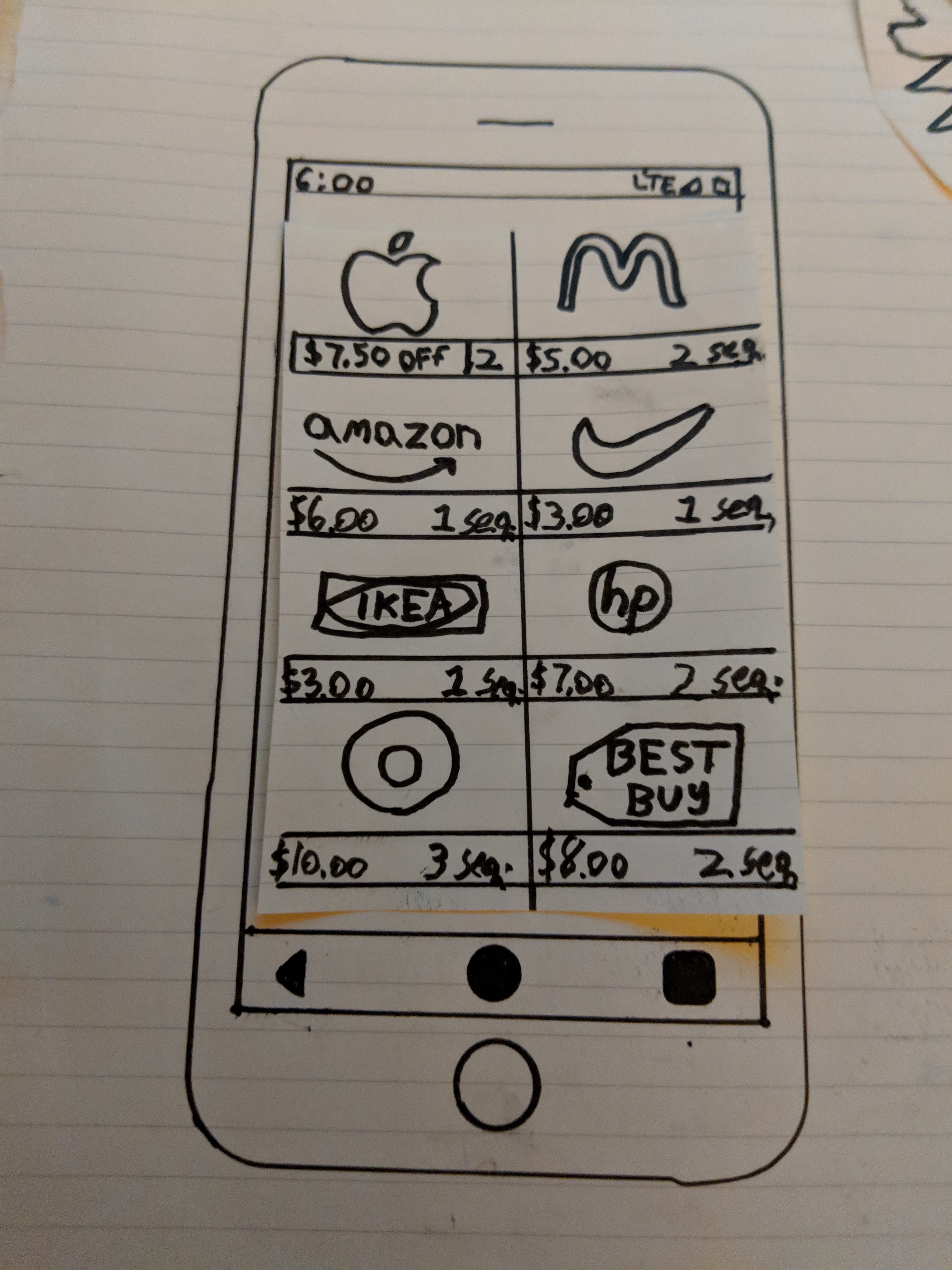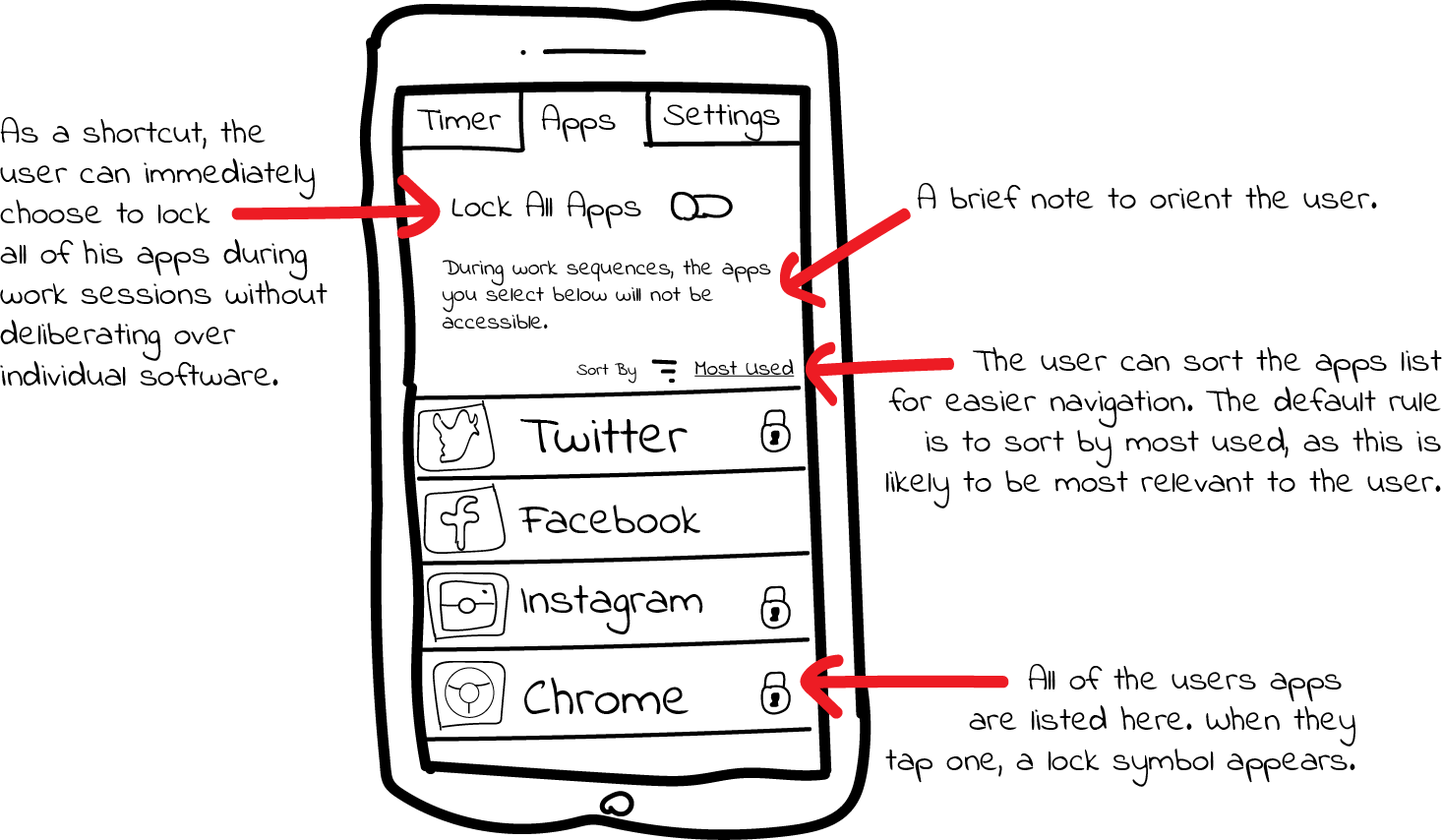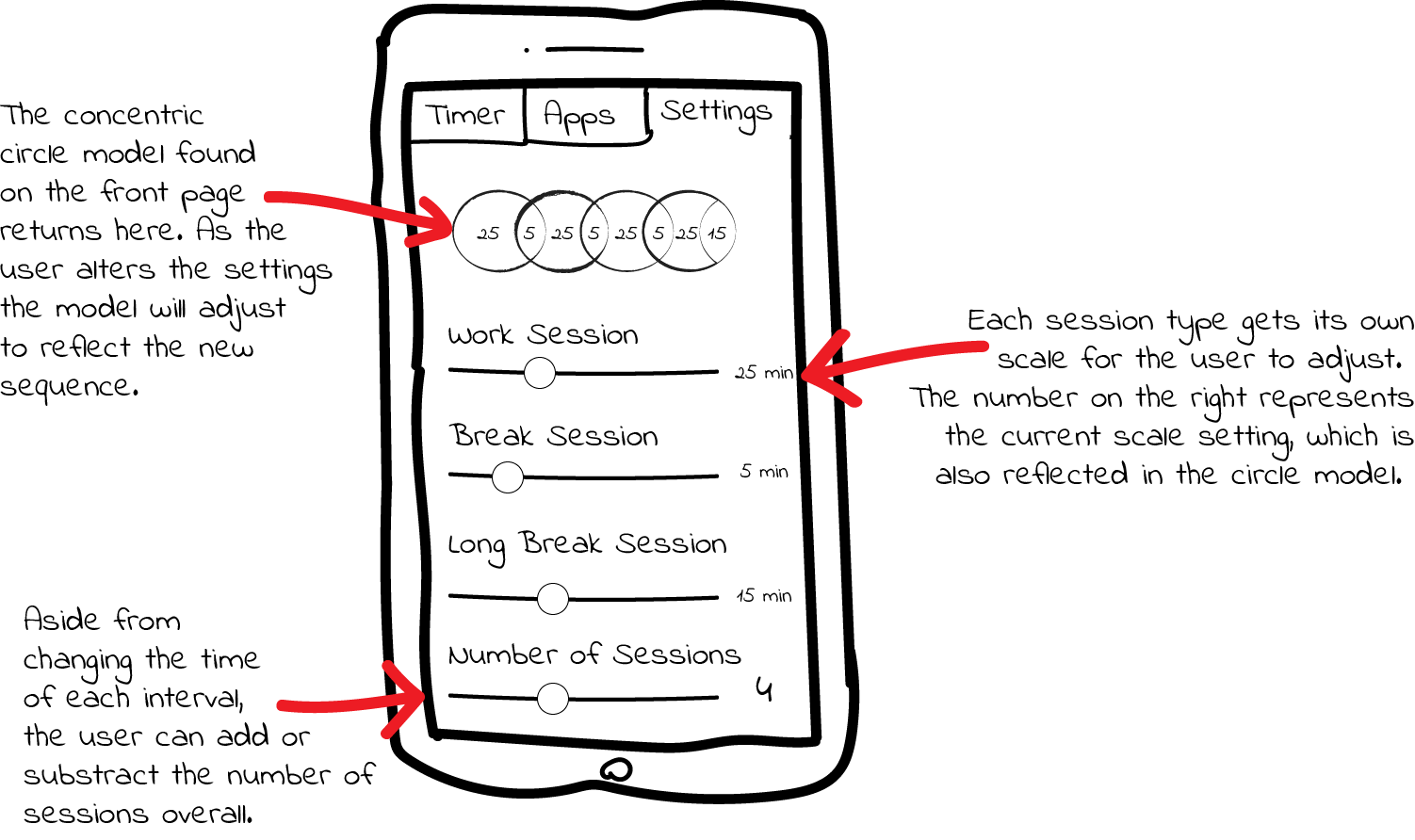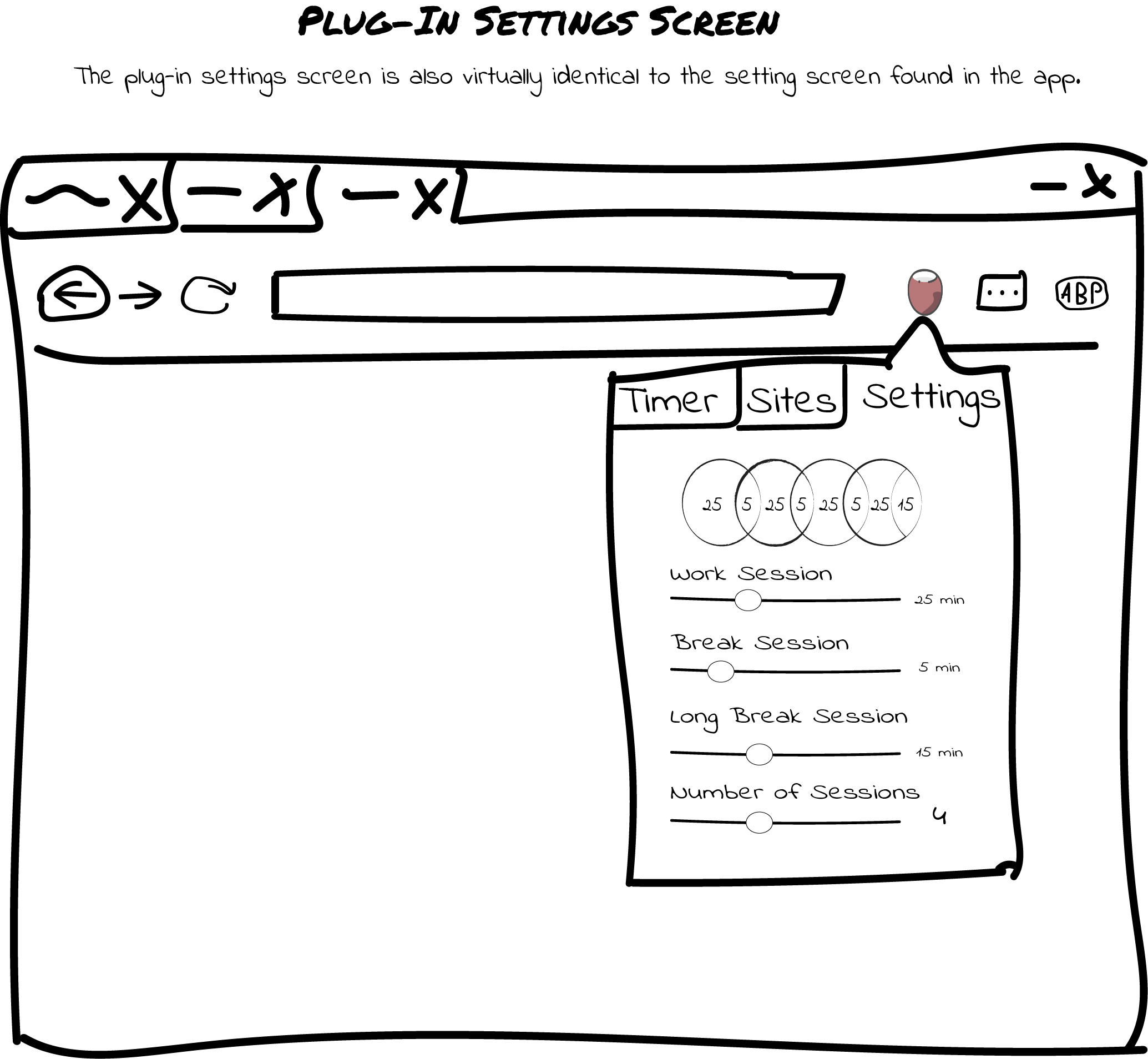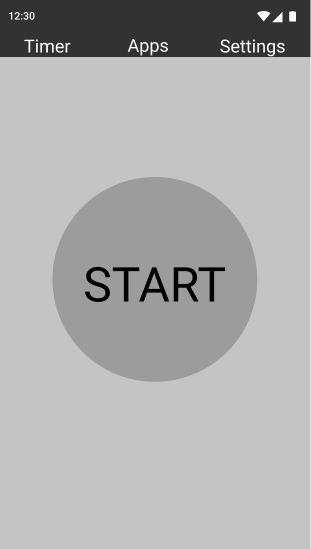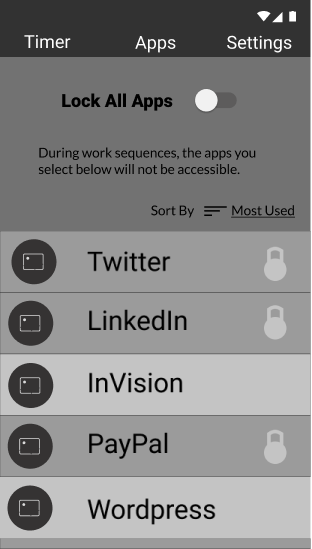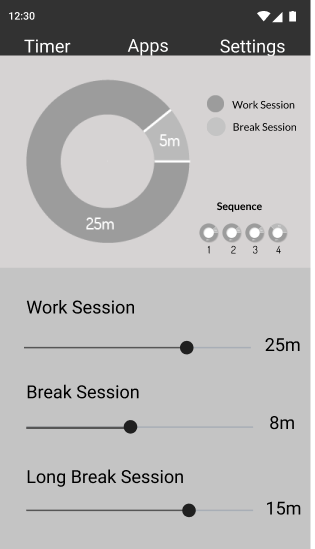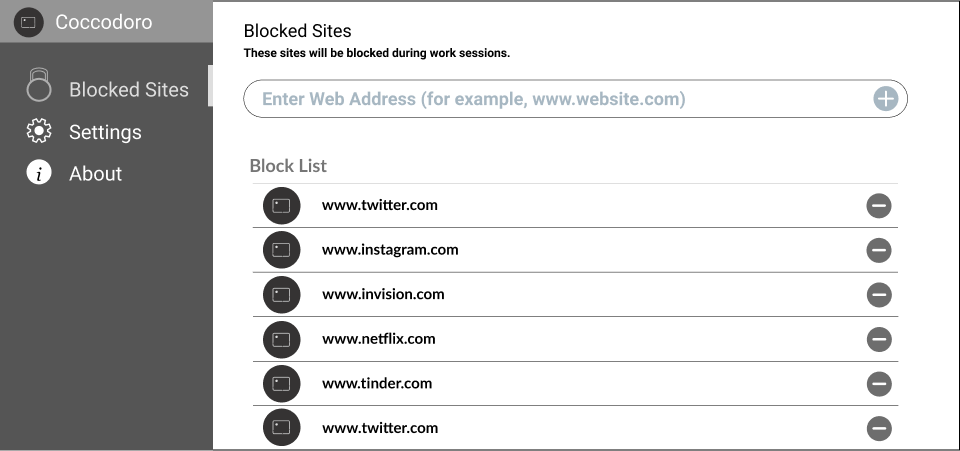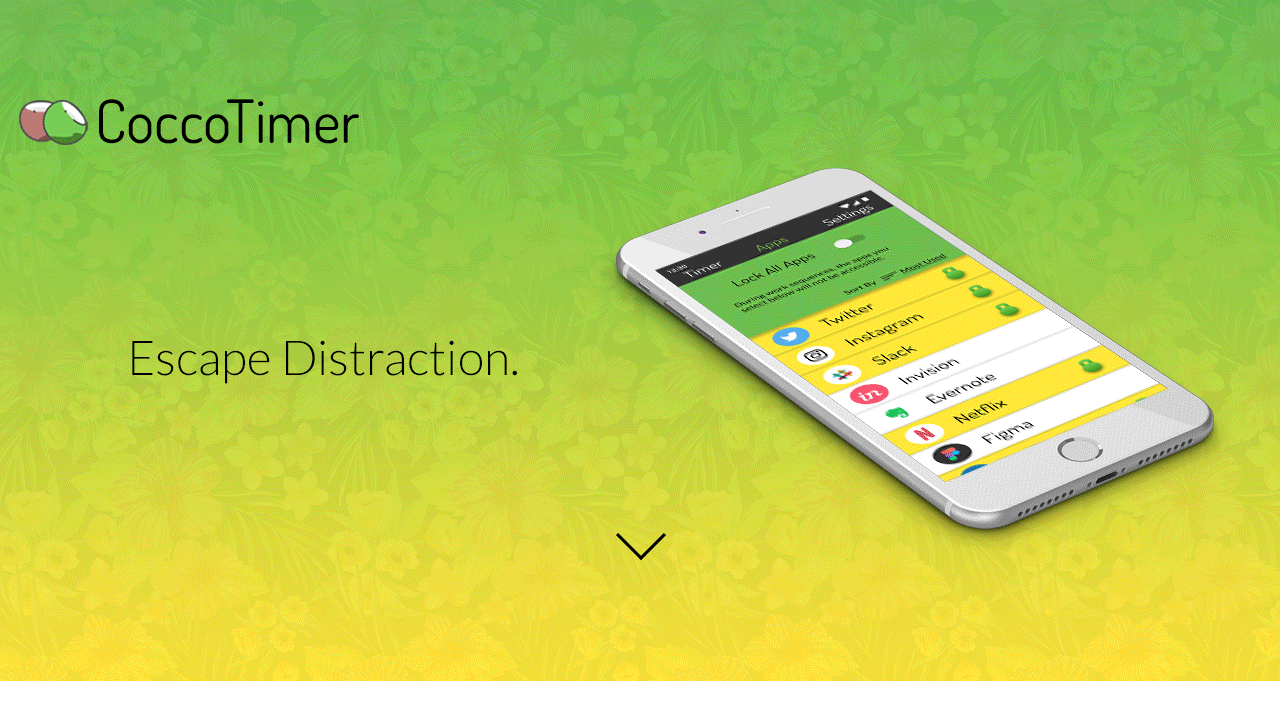

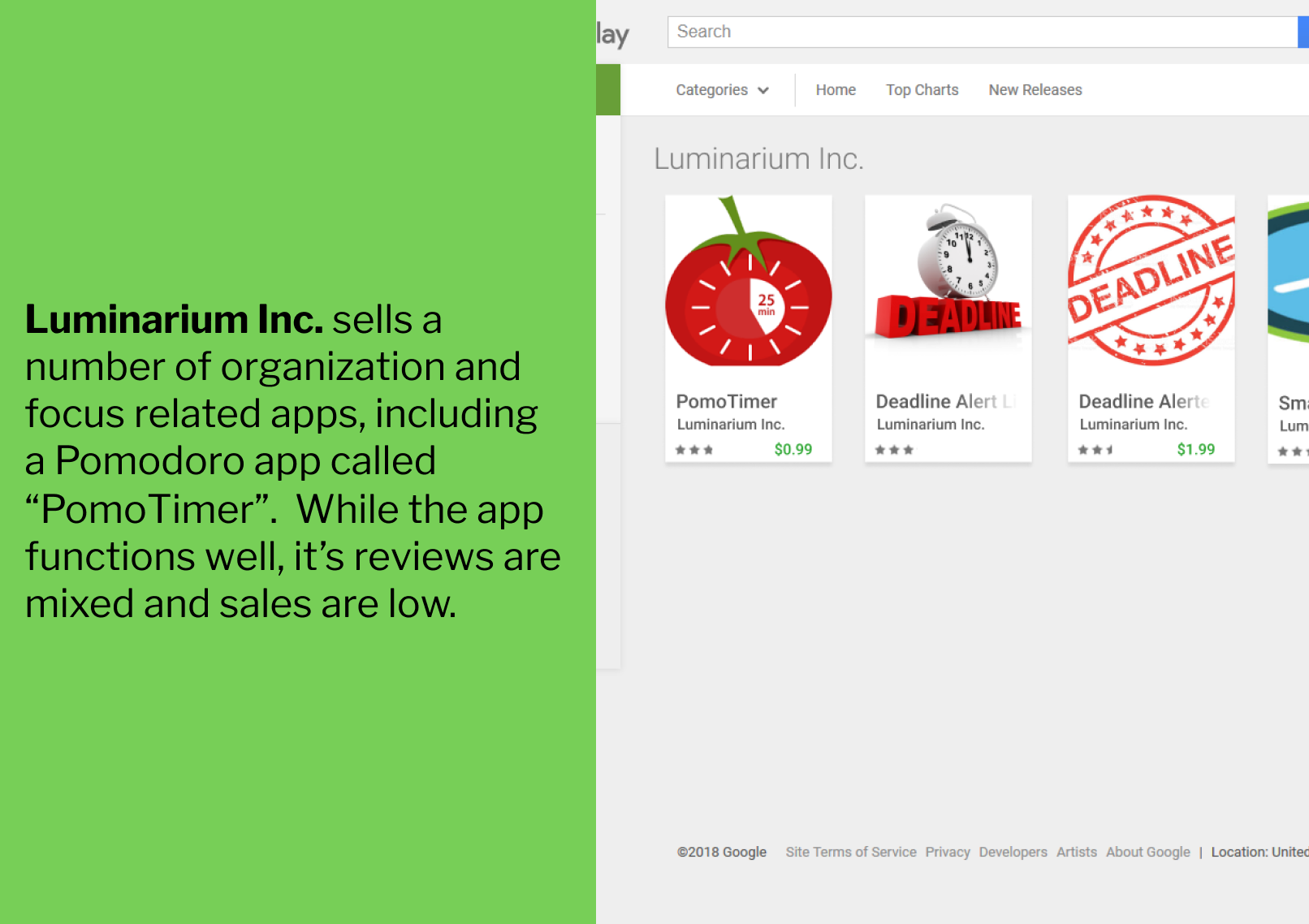
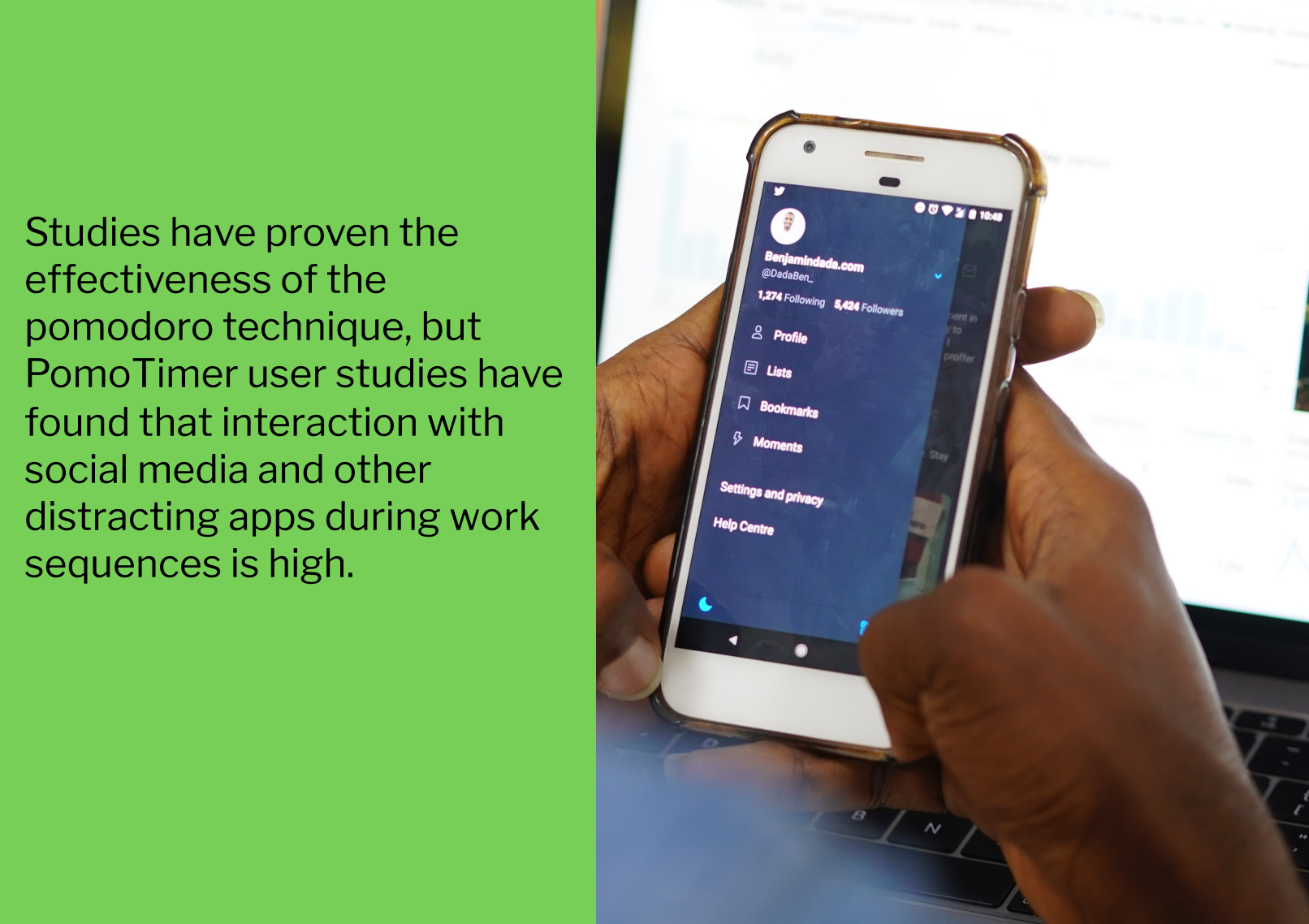

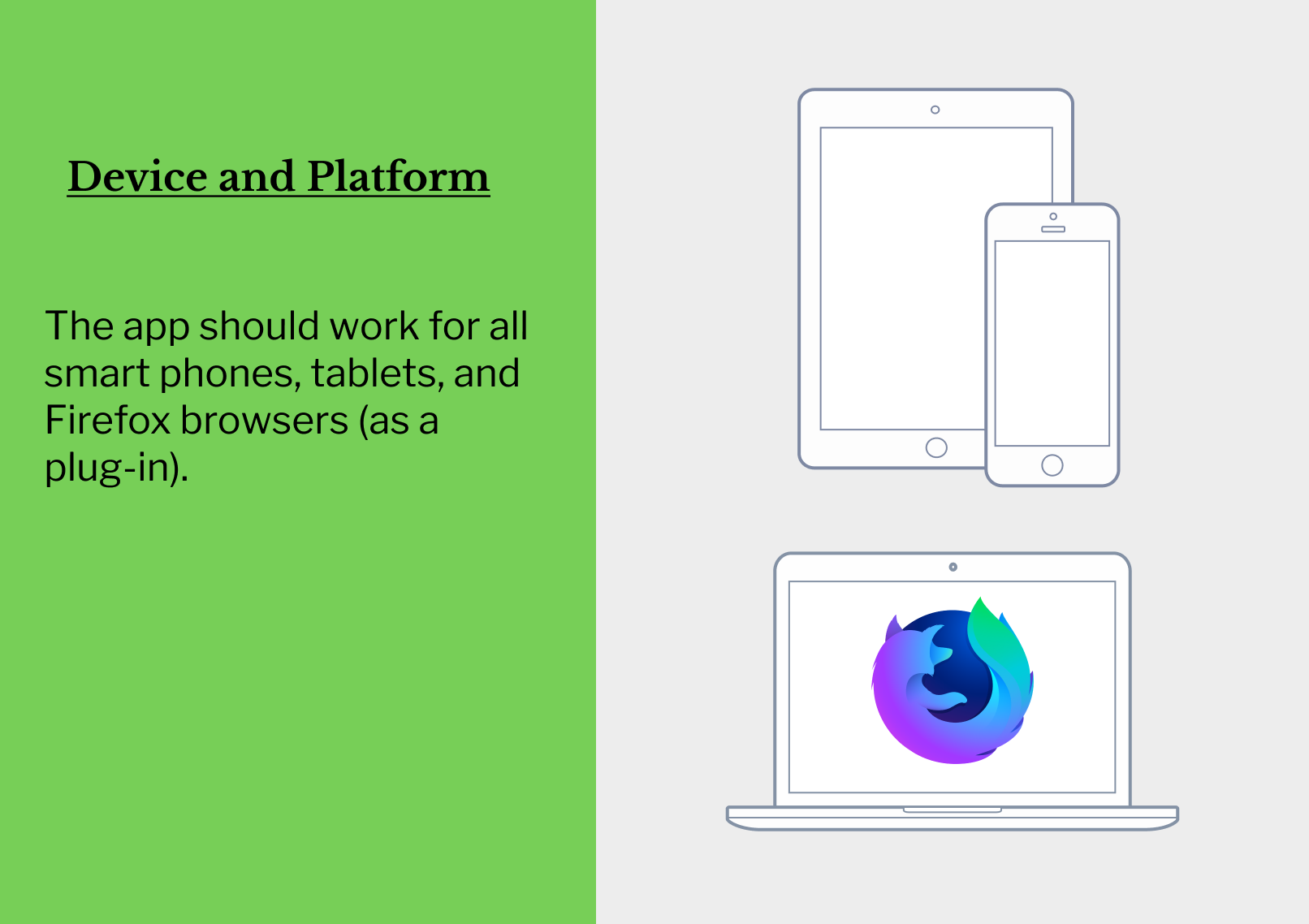


These tools were also extremely helpful in tackling this challenge.
These tools were also extremely helpful in tackling this challenge.
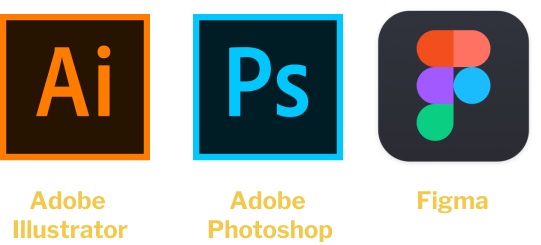
User Research
User Research
Before we began thinking of solutions, we wanted to learn more about peoples experience with the problem. We conducted user interviews with working professionals (25-40) who currently use (and struggle with) PomoTimer in their everyday routine.

Chris
Journalist
“Once I’ve taken the first leap [opening Twitter] it tends to spiral out of control until the next break”

Jenny
Fashion Designer
“...when I’m frustrated I am the most likely to ignore my timer and go post some [nonsense] to the internet”

Dori
Programmer
“I don’t usually browse during work sessions. What does happen is I’ll be enjoying my break and just not activate the next work session until maybe 10 or 15 minutes after I’m supposed to”.
These interviews served as the basis of much of our user data and empathy building exercises including personas, storyboards, and user journeys.
These interviews served as the basis of much of our user data and empathy building exercises including personas, storyboards, and user journeys.

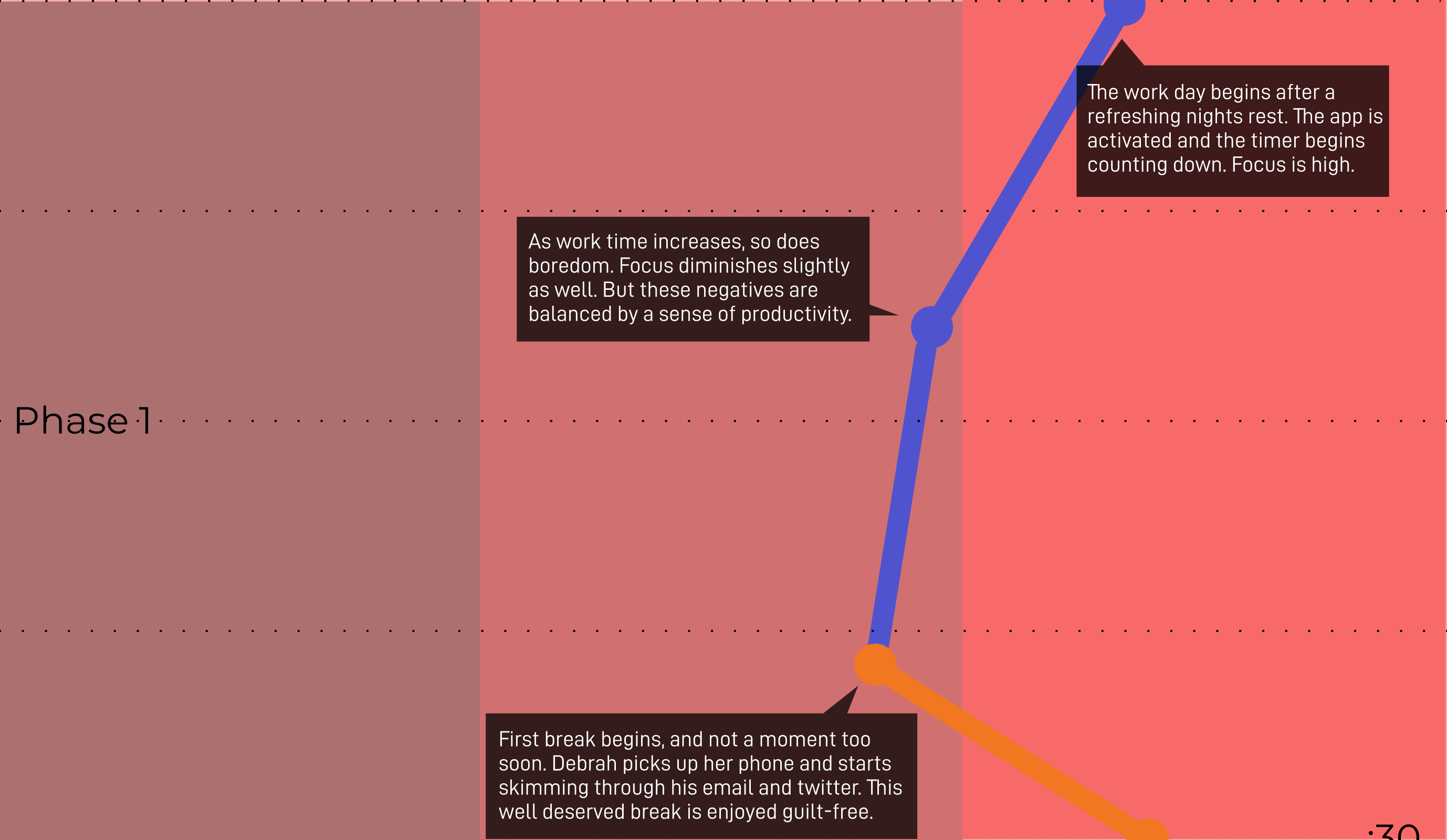
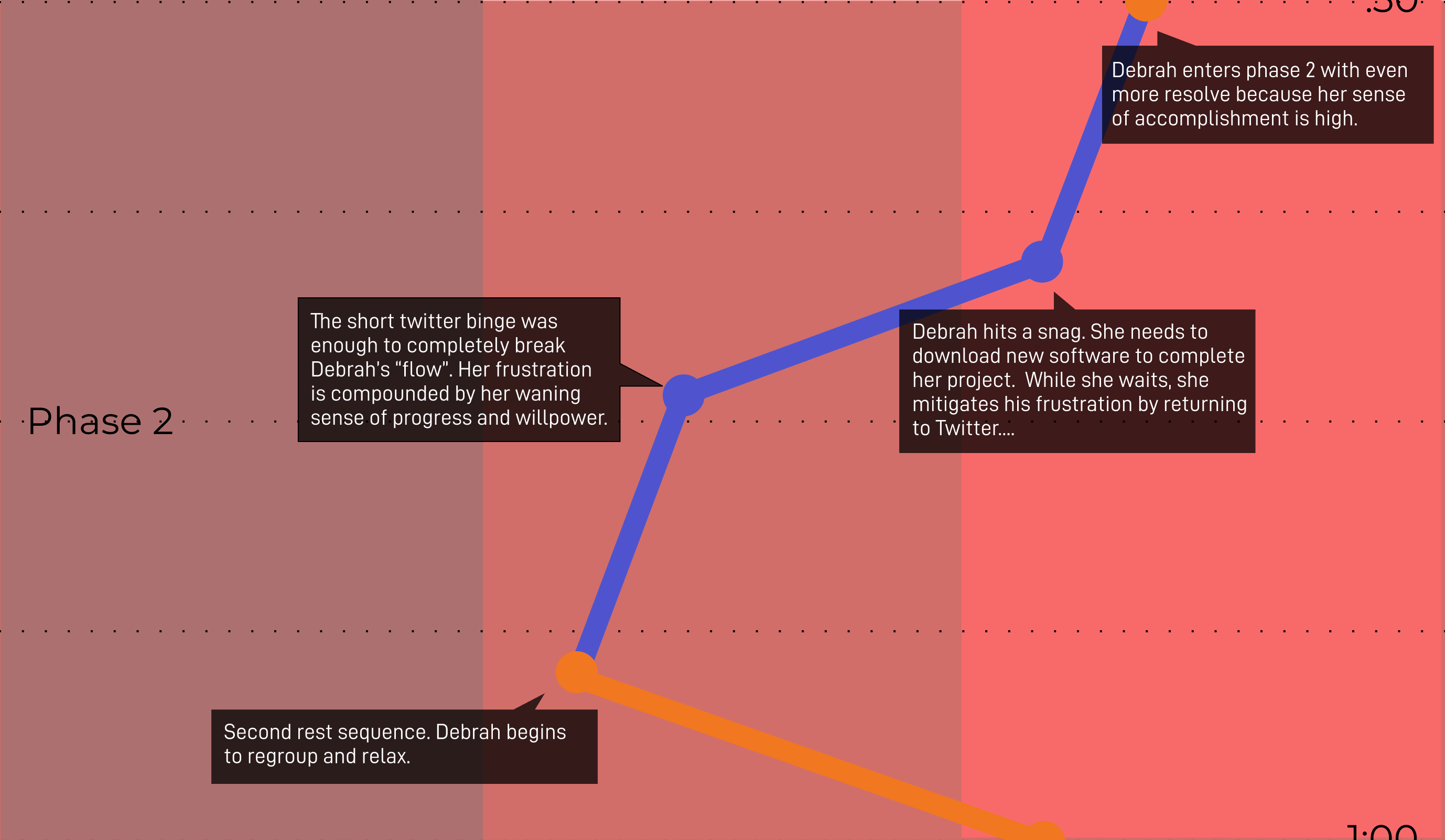

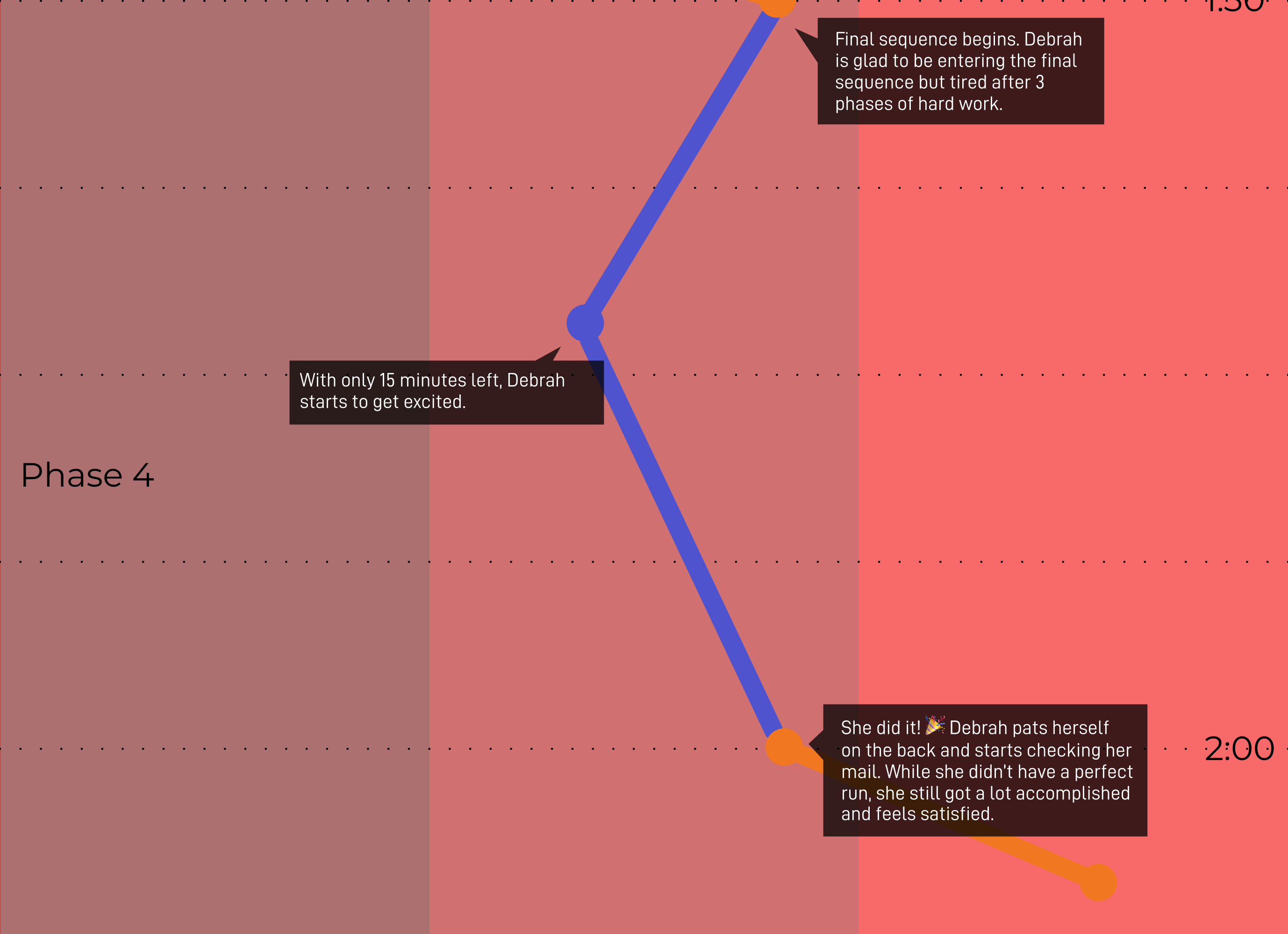
What we found over and over again with our users was a pattern of behavior often referred to as the "What-The-Hell! Effect". Users would dip their toes in a distracting app once, and then excuse future distractions because...what the hell!... they had already broken the rules of the session anyway. When it came to finding solutions, we made sure to keep the What-The-Hell! effect in mind. How can we intervene in this vicious cycle in order to enhance productivity?
Competitive Analysis
Competitive Analysis
The Vanilla
The Vanilla
App Name: Pomodoro
App Name: Pomodoro
Their are a number of apps in the vein of this product, which distills the concept of Pomodoro to its essence. It’s a timer with work and break sequences, which can be customized in terms of number of sessions and duration. That’s it!
There are a number of apps in the vein of this product, which distills the concept of Pomodoro to its essence. It’s a timer with work and break sequences, which can be customized in terms of number of sessions and duration. That’s it!
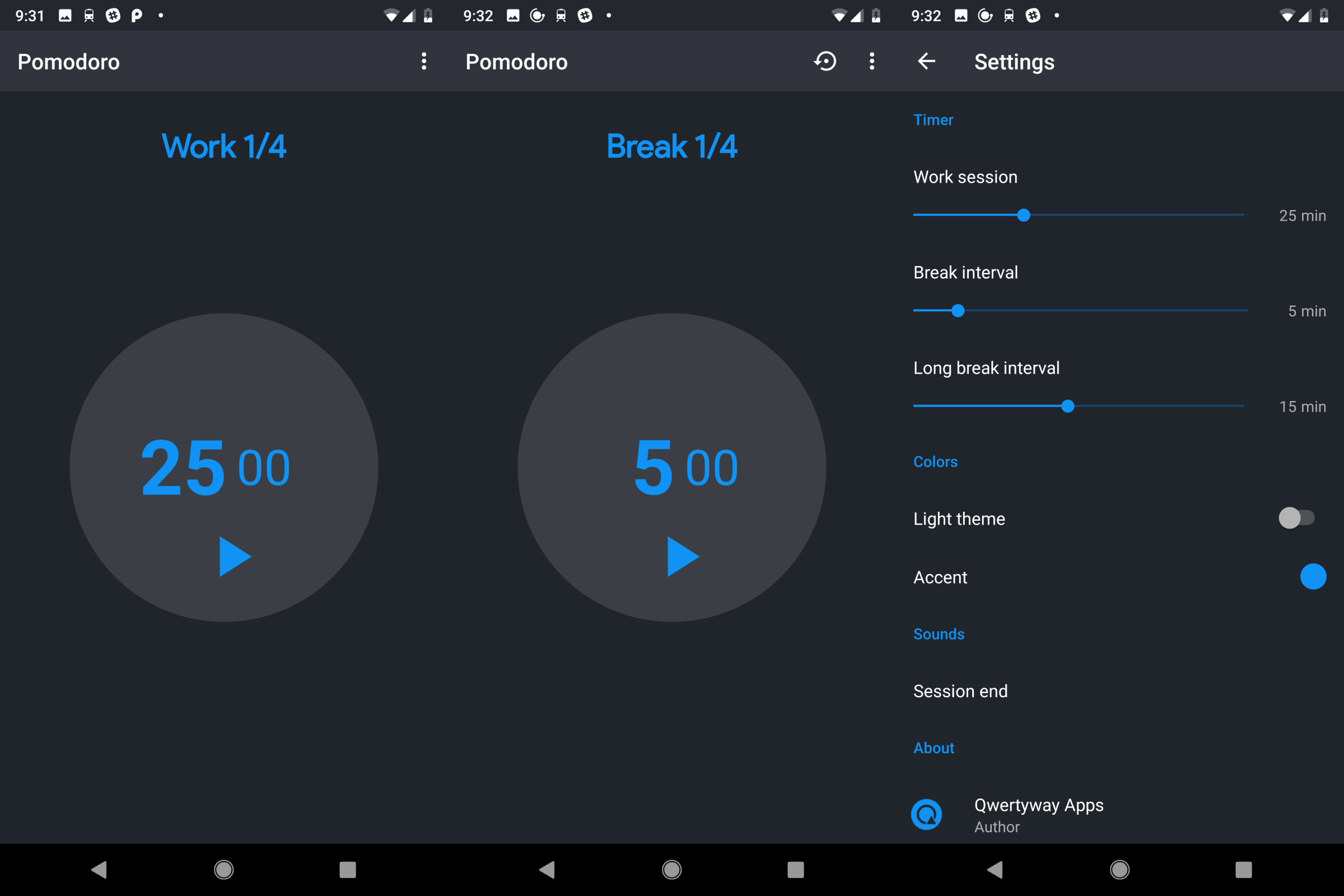
Pros
- Simple, lightweight design.
- Customizable session times and theme settings.
- No gimmicks.
- Simple, lightweight design.
- Customizable session times and theme settings.
- No gimmicks.
Cons
- It's an easy app to use but also an easy app to ignore. The user can just immediately switch to yet another distracting app after activating Pomodoro.
- Many Pomodoro apps offer long-term stats of the user's progress, but Pomodoro does not.
- It's an easy app to use but also an easy app to ignore. The user can just immediately switch to yet another distracting app after activating Pomodoro.
- Many Pomodoro apps offer long-term stats of the user's progress, but Pomodoro does not.
The Task-Master
The Task-Master
App Name: Pomi
App Name: Pomi
Pomi features a "vanilla" Pomodoro timer integrated with a task scheduler. Tapping a task on the list activates the timer with a reminder of the task across the top. This gives the user an additional point of focus during work sessions.
Pomi features a "vanilla" Pomodoro timer integrated with a task scheduler. Tapping a task on the list activates the timer with a reminder of the task across the top. This gives the user an additional point of focus during work sessions.

Pros
- Twice the functionality of a basic Pomodoro app but still relatively simple and lightweight
- Ties Pomodoro to real world activities, making it less abstract to the user.
Cons
- Like the vanilla app, it's easy to ignore.
- The only way to activate the timer is by creating an item for your Tasks list, which feels counter-intuitive.
- Despite it’s simplicity, app is prone to crashing.
The Power Point
The Power-Point
App Name: Pomentum
Pomentum and similar apps present an impressive breadth of statistical data. Users can review how much work they're accomplishing, or not accomplishing, over weeks and months. There are multiple options to determine how the data is visualized, and users can even export their data to Excel. For users who want to learn more about their own habits, Power Point Pomodoros are the way to go.
Pomentum and similar apps present an impressive breadth of statistical data. Users can review how much work they're accomplishing, or not accomplishing, over weeks and months. There are multiple options to determine how the data is visualized, and users can even export their data to Excel. For users who want to learn more about their own habits, Power-Point Pomodoros are the way to go.

Pros
- As the app's title suggests, long-term statistics can help imbue the user with a sense of momentum.
- Makes the experience of the app feel tailored to the user.
Cons
- Both positive and negative momentum are possible when you're tracking long-term progress.
- Doesn't measure the users PRODUCTIVITY (ie, how much work is actually getting done). If the user spends 20 minutes on twitter during a work session, it's still being recorded as "work" within the app.
The Motivator
The Motivator
App Name: Forest - Stay Focused
App Name: Forest - Stay Focused
Forest is one of the most unique Pomodoro apps on the market. It combines gamification and app-lock features to incentivize the user to adhere to each sequence. During the users first session, a ‘seed’ is planted on the screen. If you leave the app at any point during a work session, the plant dies. As you complete more sessions uninterrupted, your plant continues to grow.
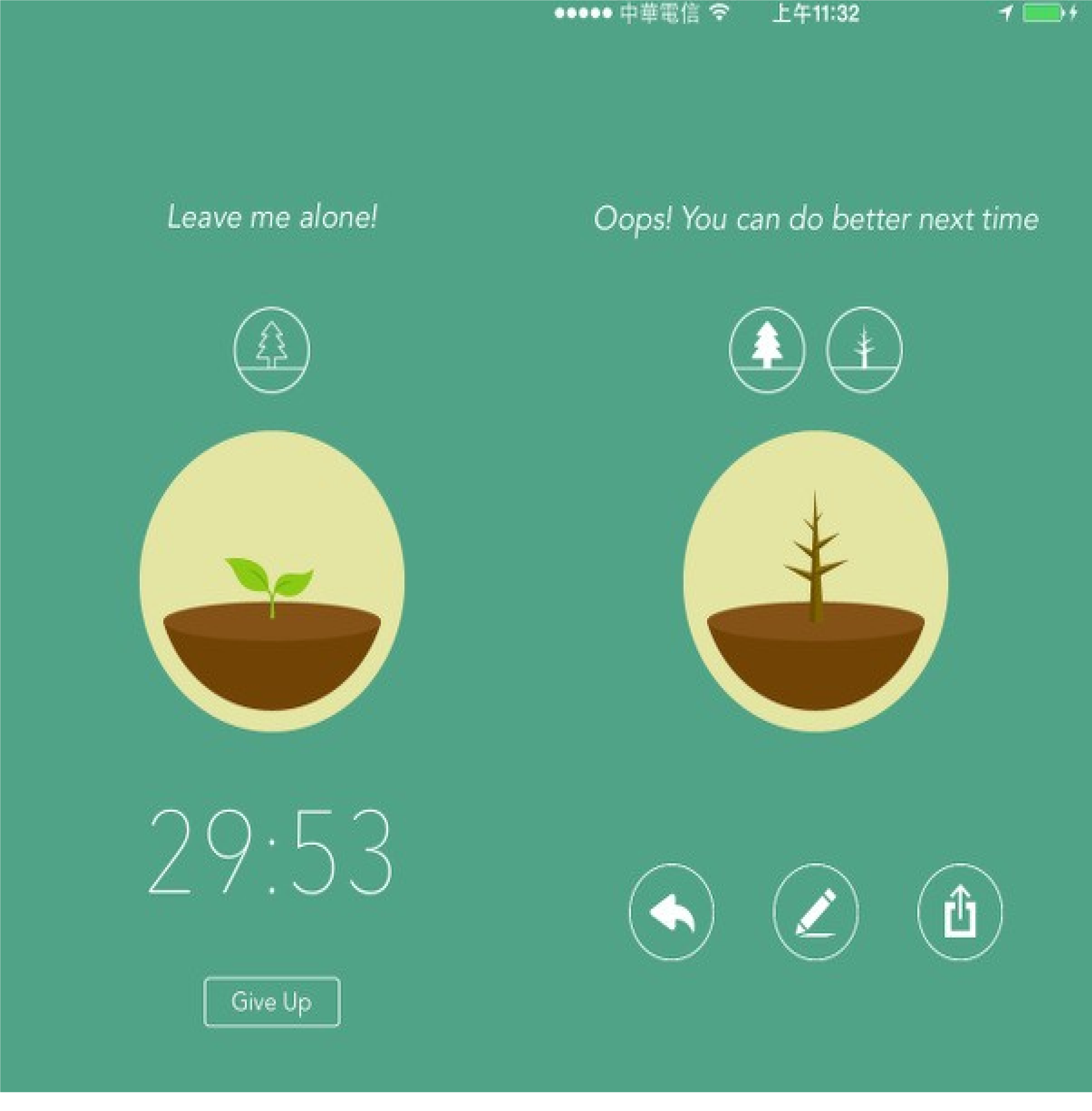
Pros
- Enforces focus by penalizing the user for using the phone for any reason during a session. -
- Forest partners with real tree-planting organizations that plants a tree when you succeed, creating an environmental incentive for user success.
- Meta-goal of creating a thriving forest, filled with customizable trees, provides additional incentive for the user.
Cons
- The app is not helpful if you need to use your phone in order to complete a task.
- The abundance of gamified features and customizations might become a new distraction for the user on its own.
Sketches
All the preceding data was used in tandem with ideation techniques including Crazy-8's and Affinity Mapping to generate potential solutions. From there we drew up some slightly more detailed concept sketches from the more popular ideas.
All the preceding data was used in tandem with ideation techniques including Crazy-8's and Affinity Mapping to generate potential solutions. From there we drew up some slightly more detailed concept sketches from the more popular ideas.
Concept 1 - Customized Incentives
Concept 1 - Customized Incentives
This app would use API's with Facebook / Spotify etc. in order to learn about the user's favorite artists, activities, and distractions. During work sessions, the main screen will display reminders of what the user has to look forward to when the break session finally comes. This could also be done through an onboarding screen asking for the user's favored activities during breaks.
Concept 2 - Negative Reinforcement
Concept 2 - Negative Reinforcement
Many Pomodoro apps feature some type of positive reinforcement, but what if we went the other way? This app would ensure that users cannot access the most distracting parts of their phone during work sessions. When it's time for a break session, all the locked apps would open for some sweet sweet recreational time. It would be incumbent on the user to determine which apps should be blocked in order to benefit their workflow.
Concept 3 - Consumer Incentives
Concept 3 - Consumer Incentives
This app attempts to create strong incentives for the user through retail discounts that can only be achieved by completing full sequences without leaving the app. When the user opens the app they will be presented with a number of available discounts and the number of sequences that need to be completed to obtain it. This app works more like "Forest" in that it requires the user to never leave the app screen during sequences, lest they lose the discount.
After some deliberation, we decided that "going dark" with a negative reinforcement app was the way to go. Paradoxically, restricting the user's overall freedom may actually benefit the user in this particular case. It would prevent the What-The-Hell! effect by not allowing users to indulge in that initial social media dive that soon becomes a spiral. Not only did it most directly addresses the UX challenge of reducing time spent distracted, but it was also something we never came across when reviewing the current Pomodoro apps on the market. Differentiating itself by filling a niche might just lead to the sales boost Luminarium is seeking. With our concept agreed upon, I began working on a higher-fidelity render.
After some deliberation, we decided that "going dark" with a negative reinforcement app was the way to go. Paradoxically, restricting the user's overall freedom may actually benefit the user in this particular case. It would prevent the What-The-Hell! effect by not allowing users to indulge in that initial social media dive that soon becomes a spiral. Not only did it most directly addresses the UX challenge of reducing time spent distracted, but it was also something we never came across when reviewing the current Pomodoro apps on the market. Differentiating itself by filling a niche might just lead to the sales boost Luminarium is seeking. With our concept agreed upon, I began working on a higher-fidelity render.
Adding Some Flavor
Adding Some Flavor

The tomato. Adopted by Pomodoro's founder in honor of a common kitchen item, the tomato timer, it's become a ubiquitous symbol of his time management technique. And when we began brainstorming about the name of our app, we started with the tomato at the center.
...But eventually, we started to wonder if we might be better represented by a more exotic member of the produce aisle.

Why the coconut? Well, it's one of the hardest fruits to open. The tough exterior contrasted with the sweet fruit within (not to mention the associations with relaxation and vacation) can be a useful metaphor for helping users understand how the app works.
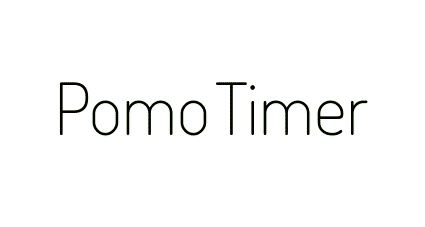
We tentatively renamed the app "CoccoTimer" (Cocco meaning coconut in Italian) to reflect our new branding.
Wireframes
Wireframes
User Testing
User Testing
With the new direction of the app beginning to crystallize, we wanted to touch base with our users and see what they felt about the changes. We put together a prototype and conducted some in-person usability tests. You can scroll to the bottom if you would like to take that test yourself.
After each test, we had our participants take a System Usability Scale questionnaire followed by some open-ended questions about their experience. The results of the questionnaire were largely positive, with an overall score of 89.3. Users responded very positively to the apps new lock feature and brighter visual design.

Chris
Journalist
Journalist
"I do feel that 'settings' should be before 'apps' in the navigation bar, so that it's in the same place it was in the old app."

Jenny
Fashion Designer
"The app locking functionality makes a lot of sense to me, I could definitely see it helping me get more done in the future".

Dori
Programmer
"I think the brighter colors are a big improvement...the app locking is something I'm excited to try"
"I think the brighter colors are a big improvement...the app locking is something I'm excited to try"
A couple of our users were having trouble adjusting to the "Apps" button usurping the place of the "Settings" button.

Old "PomoTimer" Nav Bar.
Old "PomoTimer" Nav Bar.

New "Coccodoro" Nav Bar.
New "Coccodoro" Nav Bar.
We decided that this was an issue worth exploring with some additional A/B testing.
Since we could not detect a significant difference between the two versions from a more general population, we decided to adopt Version B in order to keep our current user base happy.
The Bigger Picture
Our UX challenge was to create an app that resulted in less user distraction. While we are confident that our redesign achieves that, it is difficult to test objectively without a working prototype that actually locks peoples apps. We currently do not have a working prototype, but in the meantime, we've discussed the type of test we would like to conduct in order to measure PomoLock's effectiveness.
Hypothesis: Giving users the ability to block distracting apps beforehand will significantly reduce time spent distracted overall.
Control Group: Users in this group would use the original PomoTimer to conduct tasks.
Variable Group: Users in this group would use the new PomoTimer featuring PomoLock.
Metrics: Time Spent Distracted, (TSD for short). This is the time users spend during work sessions interacting with apps/websites not related to completing daily tasks.
Test Design: In this longitudinal study, participants would be randomly assigned to either the control or variable group and instructed to use PomoTimer to complete tasks over the span of a week. With participant consent, we will track mobile/computer user interactions during that week. The data will then be reviewed to determine TSD for each group.
Style Guides
Style Guides
The requirements were for three versions of the software, so we made a style guide that fit the specifications of each.
Project Review
Project Review

What We Learned
• The significance of qualitative data. Had we only tested the SUS of peoples experience with PomoLock, we never would have uncovered the "What-The-Hell! effect" which greatly influenced our design solution.
• In the right context, restricting some UX heuristics can paradoxically enhance the users overall experience.

What We Could Improve
• Our group fell in love with the "Coccodoro" concept, but it has it's drawbacks as a branding device. It does very little to inform people of what the product actually does, and users who have no familiarity with Pomodoro are likely to be especially baffled by the name. In retrospect, too little time was spent exploring other title concepts once Coccodoro landed.

What's Next?
• Our UX challenge remains incomplete insofar as we do not have a prototype that can achieve the lock functionality. Testing with a working prototype would determine if time spent distracted is actually reduced in practice.
• Feedback from our in-person usability tests hints at the need for an at-a-glance indicator on the timer screen that will inform the user about session length, sequence length, etc. Future iterations of the app should address this.
Test Instructions
Try It Yourself
1. Go to the "App" menu screen.
2. Lock Twitter and Instagram.
3. Go to the "Settings" menu screen.
4. Make each work session 30 minutes and each break 10 minutes.
5. Start the PomoLock timer.
6. Go to the smartphones home screen. Try to activate Twitter or LinkedIn.
7. Return to CoccoTimer and fast forward to the break session.
8. Return to the smartphone home screen. Try activating Twitter or LinkedIn again.
NOTE: To find the mobile home screen, tap anywhere on the black navigation bar on the bottom.
* The assets used for these initial tests were much more primitive than the version displayed here.


Alex lives in the downtown core of Rochester NY alongside his lovely wife Charlotte.
He enjoys playing video games, consuming media, writing, and inner city garden cats.
You can contact him at alex.kleinman@gmail.com.



